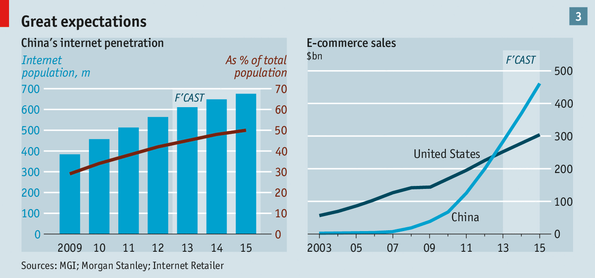Why Teespring Matters
E-commerce is taking over the world. There is no better evidence than the astonishing number put out by the e-commerce juggernaut Tmall today: In just about 38 minutes after it kicked start the double 11 shopping carnival, the Chinese equivalent of Black Friday, it has already handled its first 10 billion RMB (1.63 billion USD) worth of transactions, setting a new world record with huge margin.
E-commerce is also growing at a breathtaking speed. According to the following graph taken from Economist, the total online sales in China is expected to hit 460 billion dollars in 2015, a 50% increase from 2013.

E-commerce is the manifestation of internet as a democratizing force. It empowers people who could have been put off by the daunting task of setting up a business to pursuit their dreams because it’s so much easier to build a storefront and sell to the rest of the world online. It enables fairer and easier access of information for consumers so that overall they could enjoy better products with lower price, even in places where the growth rate of physical shops can’t keep up with people’s purchasing power. It bridges buyers and sellers who otherwise would never have their roads crossed. It promotes finer division of labor, thus facilitates innovation and produces better efficiency.
The last point contributes immensely to the prosperity of the online business. E-commerce giants such as Tmall has done a great job at taking some of the tedious tasks such as store building, payment and distribution away from merchants so that they can focus more on what they are really good at: making products and sell them. Sites like Teespring goes even further than that. By enabling merchants to sell their designs (using Tshirt as medium) more efficiently and at larger scale, it removes the burden of manufacturing from them as well. When ideas are the only differentiator for a product, it encourages more innovation in the area of design and marketing. As the result of that, manufacturing could be made more efficient as well.
I call this Manufacturing as a Service (MaaS) and believe that it has a bright future. Not all products fall into the category where its manufacturing can be completely outsourced. However sites like Teespring point out a possible direction for the future of E-commerce: if we abstract away more pain points for both the merchants and consumers, good things will happen.
